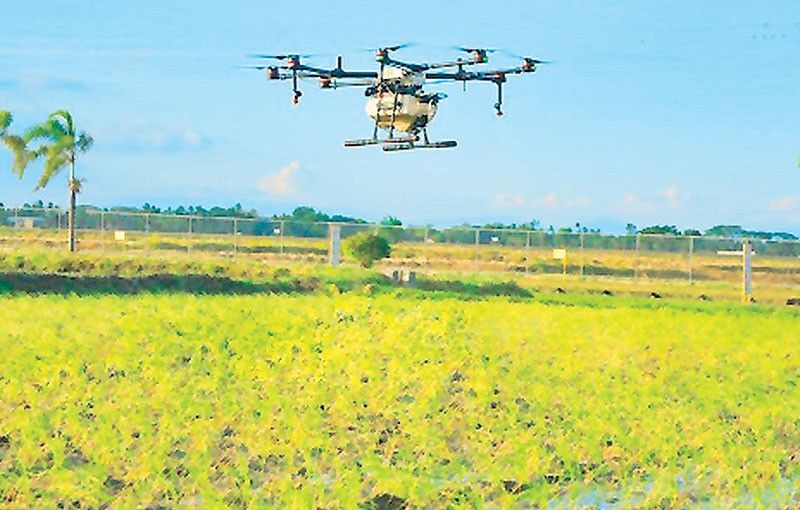Farmers get subsidized access to drone services

Taking farming to higher level
MANILA, Philippines — The government is pushing drone technology as a solution that can be adopted by rice farmers to increase their yields and lower production costs.
Thus, the Fertilizer and Pesticide Authority (FPA), together with the Department of Agriculture-National Rice Program (DA-NRP), is promoting precision agriculture through the Drones4Rice project, emphasizing its benefits for rice farmers and the need to regulate drone activities.
The initiative aims to empower rice farmers through subsidized access to drone services, said Glenn Estrada, program director of the DA’s Digitalization and Value Chain Development and Masagana Rice Industry Development Programs.
He said beneficiaries would receive vouchers worth P2,000 per hectare for the full drone-assisted farming operations, from pre-flight planning, crop establishment, nutrient management and pest and disease control.
“The NRP allotted about P300 million to support the commercial application of drones. It primarily caters to organized groups such as rice clusters, irrigators’ associations, farmers’ cooperatives and associations, small water irrigation system associations and agrarian reform beneficiaries organizations,” Estrada said.
He clarified that while DA-NRP would not purchase drones directly, the program would ensure farmers can access these services through a voucher system.
FPA executive director Julieta Lansangan said the agency would develop protocols and regulate drone use in agriculture, pointing out that drones can be used for terrorism activities.
She added that regulating drone operations in agriculture ensures the safety of users, consumers and the environment, along with the proper application of agricultural inputs.
“With the spraying of pesticides using application drone, there is a need for regulation to see the effectiveness of the product. This also ensures the safety of the user, the applicator, the community, the crops and consumer, the environment. As we go along, we develop new application technology also.”
Early this year, the Philippine Rice Research Institute (PhilRice) and the International Rice Research Institute launched the Drones4Rice project that aims, among others, to standardize protocols for drone applications of seeds, fertilizers and pesticides for rice production in the Philippines. The project also aims to reduce production cost and need for manual labor and, equally important, to attract the youth to farming.
Jasper Tallada, Drones4Rice PhilRice lead, said the utilization of drones in rice farming is rising, and can revolutionize the production of the staple as drones can optimize the application of inputs like seeds, fertilizers and pesticides, which reduces costs. More importantly, drones can reduce the labor and time to apply inputs.
“By utilizing drone technology to optimize inputs, such as seeding rates, farmers could save substantial amounts on production cost. This optimization would also expand the distribution of seeds by expanding areas of coverage, particularly through initiatives like the Rice Competitiveness Enhancement Fund,” Tallada said.
“Just imagine, it takes you half a day or a day to seed a hectare, which can easily be done in just 20 minutes by using drones,” he added.
Tallada emphasized that by showcasing the technological advancements in agriculture, the project could also help dispel misconceptions about farming being hard, which in turn, will make more young Filipinos get interested in farming.
More women will also gain interest in rice farming and can become drone operators and undertake light drone operations such as seeding and fertilizer application. This, Tallada said, will promote gender inclusivity in agricultural technology adoption.
And to allow more farmers to use drones, the project also aims to establish drone service providers, who can rent out or lease their drones to other farmers.
“We all know that 50 percent of rice production costs is manpower, and if we have service providers that can efficiently and quickly deliver these operations, labor costs would diminish,” Tallada said.
The use of drones in rice production was also included in a DA directive on the use of the P22.903-billion financial assistance intended for hybrid seeds, inorganic fertilizers, biofertilizers and ameliorants through discount vouchers and e-wallets, like the interventions monitoring card.
PhilRice has also seen an increase in the number of companies designing and manufacturing drones, with a big number of them also catering or becoming aware of the needs of farmers and food producers.
“We see this agricultural drone as a trailblazer for the digital transformation of rice production,” Tallada said.
The National Tobacco Administration (NTA) has also adopted drone technology to map tobacco plantations.
NTA administrator and CEO Belinda Sanchez said they have embraced drone technology as part of their digitalization program to validate the actual areas planted with tobacco by their farmer-partners.
“The drone technology demonstrated innovation and efficiency, enhanced NTA’s regulatory capacities and ensured fairness in the area validation of the actual tobacco plantations,” she said.
With the high-resolution aerial imaging and geospatial analysis captured by drones, the area of the tobacco plantations will accurately measure and become the basis for the computation of the volume of production. — Artemio Dumlao
- Latest
- Trending


























